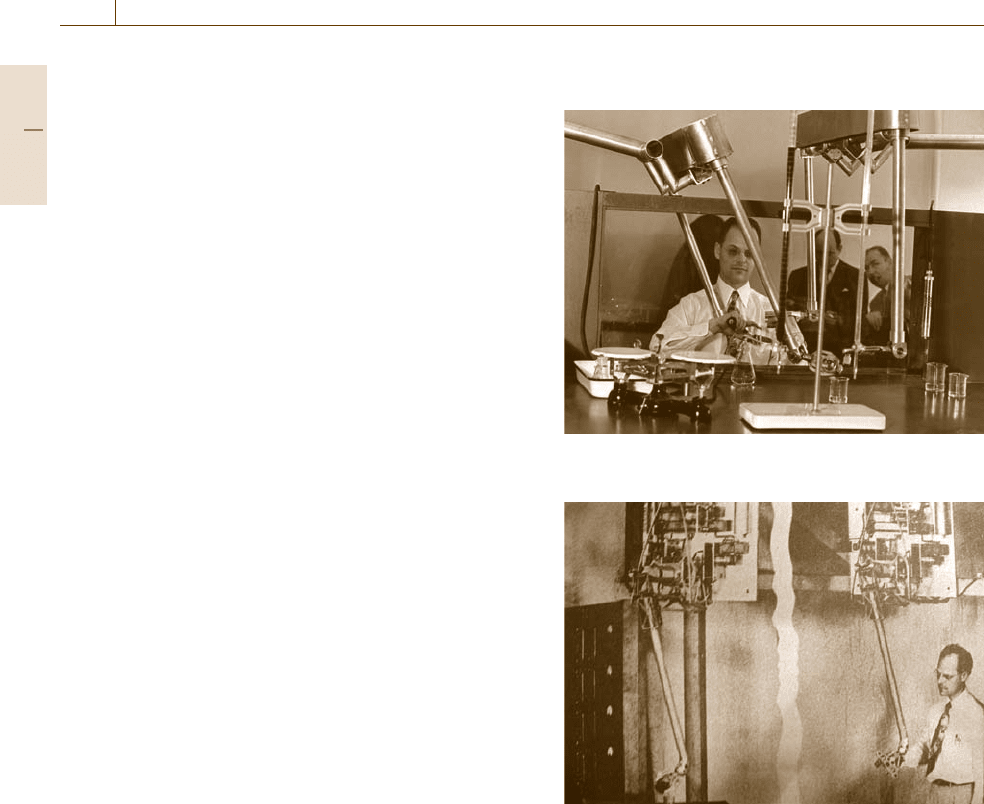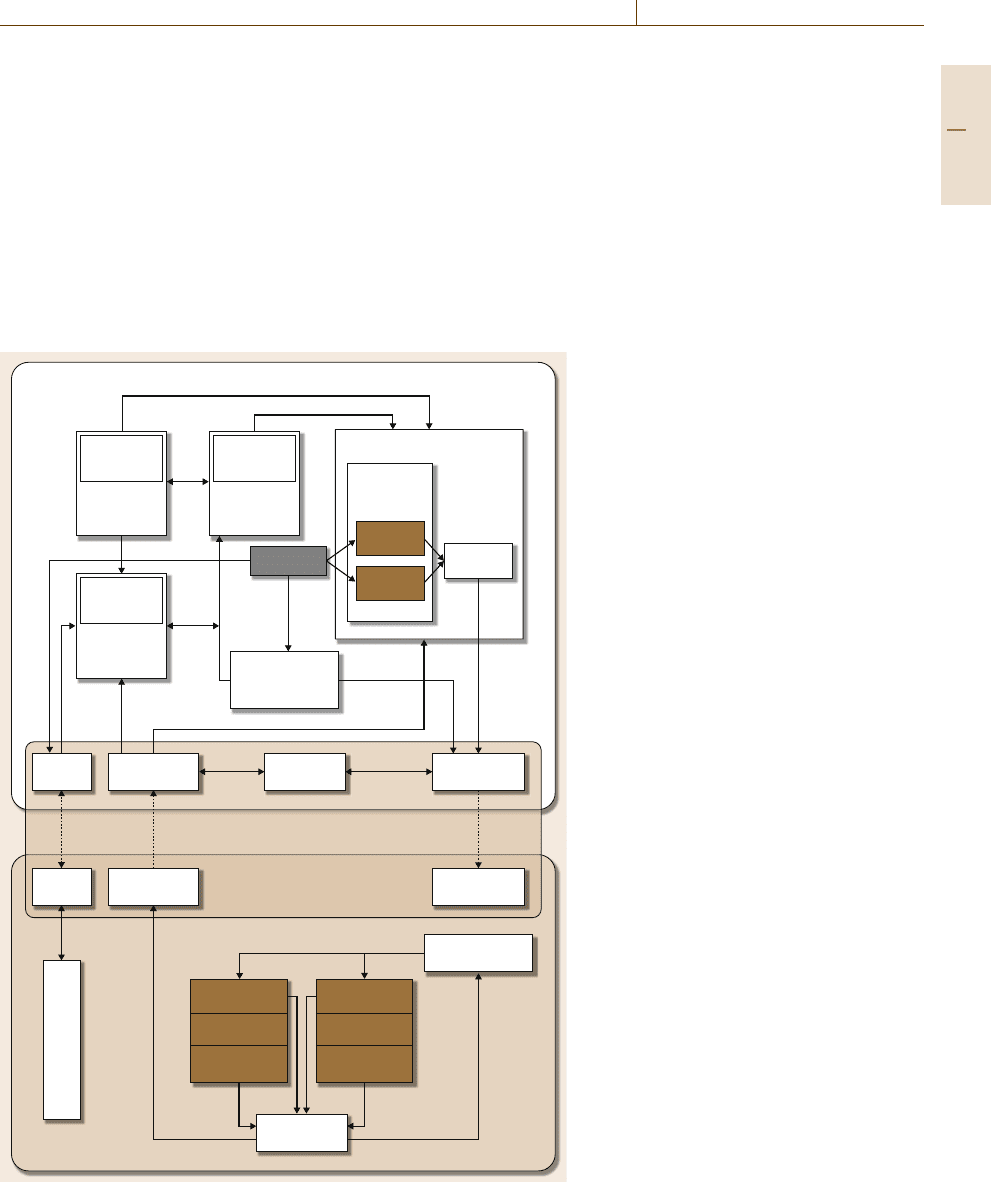Nof S.Y. Springer Handbook of Automation
Подождите немного. Документ загружается.


Collaborative Human–Automation Decision Making 26.4 Conclusion and Open Challenges 445
is (2, −1, 2) as neither the moderator nor decider roles
changed from interface 2, although the generator’s did.
The three interfaces were evaluated with 20 US
Navy personnel who would use such a tool in an op-
erational setting. While the full experimental details
can be found elsewhere [26.18], in terms of overall
performance, operators performed the best with inter-
faces 1 and2, which were notstatistically different from
each other (p =0.119). Interface 3, the one with the
predominantly automation-led collaboration, produced
statistically worse performance compared with both in-
terfaces 1 and 2 (p = 0.011 and 0.031 respectively).
Table 26.4 summarizes the HACT categorizationfor the
three interfaces, along with their relative performance
rankings. The results indicate that, because the moder-
ator and decider roles were held constant, the degraded
performance for those operators using interface 3 was
a result of the differences in the generator aspect of the
decision-making process. Furthermore, the decline in
performance occurred when the LOC was weighted to-
wards the automation. When the solution process was
either human-led or of equal contribution, operators
performed no differently. However, when the solution
generation was automation led, operators struggled.
While there are many other factors that likely af-
fect these results (trust, visualization design, etc.), the
HACT taxonomy is helpful in first deconstructing the
automation components of the decision-making pro-
cess. This allows for more specific analyses across
different collaboration levels of humans and automa-
tion, which has not been articulated in other LOA
scales. In addition, as demonstrated in the previous ex-
ample, when comparing systems, such a categorization
will alsopinpoint which LOCs are helpful, or at the very
least, not detrimental. In addition, while not explicitly
illustrated here, the HACT taxonomy can also provides
Table 26.4 Interface performance and HACT three-tuples;
M – moderator; G – generator; D – decider
HACT three-tuple Performance
(M,G,D)
Interface 1 (2, 1, 2) Best
Interface 2 (2, 0, 2) Best
Interface 3 (2, −1, 2) Worst
designers with some guidance on system design, i. e.,
to improve performance for a system; for example, in
interface 3, it may be better to increase the moderator
LOC instead of lowering the generator LOC.
In summary, application of HACT is meant to elu-
cidate human–computer collaboration in terms of an
information processing theoretic framework. By decon-
structing either a single or competing decision support
systems using the HACT framework, a designer can
better understand how humans and computers are col-
laborating across different dimensions, in order to
identify possible problem areas in need of redesign; for
example, in the case of the Patriot missile system with
a(−2, −2, 1) three-tuple and its demonstratedpoor per-
formance, designers could change the decider role to
a 2 (only the human makes the final decision, automa-
tion cannot veto), as well as move towards a more truly
collaborative solution generation LOC. Because missile
intercept is a time-pressured task, it is important that
the automation moderate the task, but because of the
inability of the automation to always correctly make
recommendations, more collaboration is needed across
the solution-generationrole, withno automation author-
ity in the decider role. Used in this manner, HACT aids
designers in the understandingof the multiagent rolesin
human–computer collaboration tasks, as well as identi-
fying areas for possible improvement across these roles.
26.4 Conclusion and Open Challenges
The human–automation collaboration taxonomy
(HACT) presented here builds on previous research
by expanding the Parasuraman [26.1] information
processing model, specifically the decision-making
component. Instead of defining a simple level of au-
tomation for decision making, we deconstruct the
process to include threedistinct roles, thatof the moder-
ator (the agent that ensures the decision-making process
moves forward), the generator (the agent that is pri-
marily responsible for generating a solution or set of
possible solutions), and the decider (the agent that
decides the final solution along with veto authority).
These three distinct (but not necessarily mutually ex-
clusive) roles can each be scaled across five levels
indicating degrees of collaboration, with the center
value of 0 in each scale representing balanced col-
laboration. These levels of collaboration (LOCs) form
a three-tuple that can be analyzed to evaluate system
collaboration, and possibly identify areas for design
intervention.
Part C 26.4

446 Part C Automation Design: Theory, Elements, and Methods
As with all such levels, scales, taxonomies, etc.,
there are limitations. First, HACT as outlined here does
not address all aspects of collaboration that could be
considered when evaluating the collaborative nature of
a system, such as the type and possible latencies in
communication, whether or not the LOCs should be dy-
namic, the transparency of the automation, the type of
information used (i.e., low-level detail as opposed to
higher, more abstract concepts), and finally how adapt-
able the system is across all of these attributes. While
this has been discussed in earlier work [26.7], more
work is needed to incorporate this into a comprehensive
yet useful application.
In addition, HACT is descriptive versus prescrip-
tive, which means that it can describe a system and
identify post hocwhere designsmay be problematic, but
cannot indicative how the system should be designed to
achieve some predicted outcome. To this end, more re-
search is needed in the application of HACT and the
interrelation of the entries within each three-tuple, as
well as more general relationships across three-tuples.
Regarding the within three-tuples issue, more research
is needed to determine the impact and relative impor-
tance of each of the three roles; for example, if the
moderator is at a high LOC but the generator is at
alowLOC, are there generalizable principles that can
be seen across different decision support systems? In
terms of the between three-tuple issue, more research
is needed to determine under what conditions certain
three-tuples produce consistently poor (or superior) per-
formance, and whether these are generalizable under
particular contexts; for example, in high-risk time-
critical supervisory control domains such as nuclear
power plant operations, a three-tuple of (−2, −2, −2)
may be necessary. However, even in this case, given
flawed automated algorithms such as those seen in
the Patriot missile, the question could be raised of
whether it is ever feasible to design a safe (−2, −2, −2)
system.
Despite these limitations, HACT provides more de-
tailed information about the collaborative nature of
systems than did previous level-of-automation scales,
and given the increasing presence of intelligent au-
tomation both in complex supervisory control systems
and everyday life, such as global positioning system
(GPS) navigation, this sort of taxonomy can provide for
more in-depth analysis and a common point of com-
parison across competing systems. Other future areas
of research that could prove useful would be the de-
termination of how levels of collaboration apply in the
other data acquisition and action implementation in-
formation processing stages, and what the impact on
human performance would be if different collaboration
levels were mixed across the stages. Lastly, one area
often overlooked that deserves much more attention is
the ethical and social impact of human–computer col-
laboration. Higher levels of automation authority can
reduce an operator’s awareness of criticalevents [26.19]
as well as reduce their sense of accountability [26.20].
Systems that promote collaboration with an automated
agent could possibly alleviate the offloading of attention
and accountability to the automation, or collaboration
may further distance operators from their tasks and ac-
tions and promote these biases. There has been very
little research in this area, and given the vital nature
of many time-critical systems that have some degree of
human–computer collaboration (e.g., air-traffic control
and military command and control), the importance of
the social impact of such systems should not be over-
looked.
References
26.1 R. Parasuraman, T.B. Sheridan, C.D. Wickens:
A model for types and levels of human interaction
with automation, IEEE Trans. Syst. Man Cybern. –
Part A: System and Humans 30(3), 286–297 (2000)
26.2 P. Dillenbourg, M. Baker, A. Blaye, C. O’Malley:
The evolution of research on collaborative learn-
ing. In: Learning in Humans and Machines.
Towards an Interdisciplinary Learning Science,ed.
by P. Reimann, H. Spada (Pergamon, London 1995)
pp. 189–211
26.3 J. Roschelle, S. Teasley: The construction of shared
knowledge in collaborative problem solving. In:
Computer Supported Collaborative Learning,ed.by
C. O’Malley (Springer, Berlin 1995) pp. 69–97
26.4 P.J. Smith, E. McCoy, C. Layton: Brittleness in the
design of cooperative problem-solving systems:
the effects on user performance, IEEE Trans. Syst.
Man Cybern. 27(3), 360–370 (1997)
26.5 H.A. Simon, G.B. Dantzig, R. Hogarth, C.R. Plott,
H.Raiffa,T.C.Schelling,R.Thaler,K.A.Shepsle,
A. Tversky, S. Winter: Decision making and problem
solving, Paper presented at the Research Briefings
1986: Report of the Research Briefing Panel on De-
cision Making and Problem Solving, Washington
D.C. (1986)
26.6 P.M. Fitts (ed.): Human Engineering for an Effective
Air Navigation and Traffic Control system (National
Research Council, Washington D.C. 1951)
Part C 26

Collaborative Human–Automation Decision Making References 447
26.7 S. Bruni, J.J. Marquez, A. Brzezinski, C. Nehme,
Y. Boussemart: Introducing a human–automation
collaboration taxonomy (HACT) in command and
control decision-support systems, Paper presented
at the 12th Int. Command Control Res. Technol.
Symp., Newport (2007)
26.8 M.P. Linegang, H.A. Stoner, M.J. Patterson,
B.D. Seppelt, J.D. Hoffman, Z.B. Crittendon,
J.D. Lee: Human–automation collaboration in dy-
namic mission planning: a challenge requiring an
ecological approach, Paper presented at the Hu-
man Factors and Ergonomics Society 50th Ann.
Meet., San Francisco (2006)
26.9 Y. Qinghai, Y. Juanqi, G. Feng: Human–computer
collaboration control in the optimal decision of FMS
scheduling, Paper presented at the IEEE Int. Conf.
Ind. Technol. (ICIT ’96), Shanghai (1996)
26.10 R.E. Valdés-Pérez: Principles of human–computer
collaboration for knowledge discovery in science,
Artif. Intell. 107(2), 335–346 (1999)
26.11 B.G. Silverman: Human–computer collaboration,
Hum.–Comput. Interact. 7(2), 165–196 (1992)
26.12 L.G. Terveen: An overview of human–computer
collaboration, Knowl.-Based Syst. 8(2–3), 67–81
(1995)
26.13 G. Johannsen: Mensch-Maschine-Systeme (Hu-
man–Machine Systems) (Springer, Berlin 1993), in
German
26.14 J. Rasmussen: Skills, rules, and knowledge; sig-
nals, signs, and symbols, and other distractions in
human performance models, IEEE Trans. Syst. Man
Cybern. 13(3), 257–266 (1983)
26.15 T.B.Sheridan,W.Verplank:Human and Computer
Control of Undersea Teleoperators (MIT, Cambridge
1978)
26.16 M.R. Endsley, D.B. Kaber: Level of automation
effects on performance, situation awarness and
workload in a dynamic control task, Ergonomics
42(3), 462–492 (1999)
26.17 V. Riley: A general model of mixed-initiative
human–machine systems, Paper presented at the
Human Factors Society 33rd Ann. Meet., Denver
(1989)
26.18 S. Bruni, M.L. Cummings: Tracking resource
allocation cognitive strategies for strike plan-
ning, Paper presented at the COGIS 2006, Paris
(2006)
26.19 K.L. Mosier, L.J. Skitka: Human decision mak-
ers and automated decision aids: made for each
other? In: Automation and Human Performance:
Theory and Applications, ed. by R. Parasuraman,
M. Mouloua (Lawrence Erlbaum, Mahwah 1996)
pp. 201–220
26.20 M.L. Cummings: Automation and accountability in
decision support system interface design, J. Tech-
nol. Stud. 32(1), 23–31 (2006)
Part C 26
“This page left intentionally blank.”

449
Teleoperation
27. Teleoperation
Luis Basañez, Raúl Suárez
This chapter presents an overview of the tele-
operation of robotics systems, starting with
a historical background, and including the
description of an up-to-date specific teleop-
eration scheme as a representative example
to illustrate the typical components and func-
tional modules of these systems. Some specific
topics in the field are particularly discussed,
for instance, control algorithms, communica-
tions channels, the use of graphical simulation
and task planning, the usefulness of virtual
and augmented reality, and the problem of
dexterousgrasping.Thesecondpartofthe
chapter includes a description of the most
typical application fields, such as industry
and construction, mining, underwater, space,
surgery, assistance, humanitarian demining,
and education, where some of the pio-
neering, significant, and latest contributions
are briefly presented. Finally, some conclu-
sions and the trends in the field close the
chapter.
The topics of this chapter are closely related
to the contents of other chapters such as those
on Communication in Automation, Including
Networking and Wireless (Chap. 13), Virtual
27.1 Historical Background
and Motivation .................................... 450
27.2 General Scheme and Components .......... 451
27.2.1 Operation Principle ..................... 454
27.3 Challenges and Solutions ...................... 454
27.3.1 Control Algorithms ...................... 454
27.3.2 Communication Channels............. 455
27.3.3 Sensory Interaction and Immersion 456
27.3.4 Teleoperation Aids ...................... 457
27.3.5 Dexterous Telemanipulation ......... 458
27.4 Application Fields ................................. 459
27.4.1 Industry and Construction ............ 459
27.4.2 Mining....................................... 460
27.4.3 Underwater ................................ 460
27.4.4 Space......................................... 461
27.4.5 Surgery ...................................... 462
27.4.6 Assistance .................................. 463
27.4.7 Humanitarian Demining .............. 463
27.4.8 Education................................... 464
27.5 Conclusion and Trends .......................... 464
References .................................................. 465
Reality and Automation (Chap. 15), and Collab-
orative Human–Automation Decision Making
(Chap. 26).
The term teleoperation is formed as a combination of
the Greek word τηλε-, (tele-, offsite or remote), and
the Latin word operat
˘
ıo, -
¯
onis (operation, something
done). So, teleoperation means performing some work
or action from some distance away. Although in this
sense teleoperation could be applied to any operation
performed at a distance, this term is most commonly as-
sociated with robotics and mobile robots and indicates
the driving of one of these machines from a place far
from the machine location.
There are of lot of topics involved in a tele-
operated robotic system, including human–machine
interaction, distributed control laws, communications,
graphic simulation, task planning, virtual and aug-
mented reality, and dexterous grasping and manipula-
tion. Also the fields of application of these systems
are very wide and teleoperation offers great possi-
bilities for profitable applications. All these topics
and applications are dealt with in some detail in this
chapter.
Part C 27

450 Part C Automation Design: Theory, Elements, and Methods
27.1 Historical Background and Motivation
Since a long time ago, human beings have used a range
of tools to increase their manipulation capabilities. In
the beginning these tools were simple tree branches,
which evolved to long poles with tweezers, such as
blacksmith’s tools that help to handle hot pieces of iron.
These developments were the ancestors of master–slave
robotic systems, where the slave robot reproduces the
master motions controlled by a human operator. Tele-
operated robotic systems allow humans to interact with
robotic manipulators and vehicles and to handle objects
located in a remote environment, extending human ma-
nipulation capabilities to far-off locations, allowing the
execution of quite complex tasks and avoiding danger-
ous situations.
The beginnings of teleoperation can be traced back
to the beginnings of radio communication when Nikola
Tesla developed what can be considered the first tele-
operated apparatus, dated 8 November 1898. This
development has been reported under the US patent
613809, Method of and Apparatus for Controlling
Mechanism of Moving Vessels or Vehicles.However,bi-
lateral teleoperation systems did not appear until the
late 1940s. The first bilateral manipulators were de-
veloped for handling radioactive materials. Outstanding
pioneers were Raymond Goertz and his colleagues at
the Argonne National Laboratory outside of Chicago,
and Jean Vertut at a counterpart nuclear engineering
laboratory near Paris. The first mechanisms were me-
chanically coupled and the slave manipulator mimicked
the master motions, both being very similar mecha-
nisms (Fig. 27.1). It was not until the mid 1950s that
Goertz presented the first electrically coupled master–
slave manipulator (Fig.27.2) [27.1].
In the 1960s applications were extended to under-
water teleoperation, where submersible devices carried
cameras and the operator could watch the remote robot
and its interaction with the submerged environment.
The beginnings of space teleoperation dates form the
1970s, and in this applicationthe presence of time delay
started to cause instability problems.
Technology has evolved with giant steps, resulting
in better robotic manipulators and, in particular, in-
creasing the communication means, from mechanical to
Fig. 27.1 Raymond Goertz with the first mechanically cou-
pled teleoperator (Source: Argonne National Labs)
Fig. 27.2 Raymond Goertz with an electrically coupled
teleoperator (Source: Argonne National Labs)
electrical transmission, using optic wires, radio signals,
and the Internet which practically removes any distance
limitation.
Today, the applications of teleoperation systems are
found in a large number of fields. The most illustra-
tive are space, underwater, medicine, and hazardous
environments, which are described amongst others
in Sect.27.4
Part C 27.1

Teleoperation 27.2 General Scheme and Components 451
27.2 General Scheme and Components
A modern teleoperation system is composed of several
functional modules according to the aim of the system.
As a paradigm of an up-to-date teleoperated robotic
system, the one developed at the Robotics Laboratory
of the Institute of Industrial and Control Engineering
(IOC), Technical University of Catalonia (UPC), Spain,
will be described below [27.2].
The outline of the IOC teleoperation system is rep-
resented in Fig. 27.3. The diagram contains two large
blocks that correspond to the local station, where the
Simulation
module
Simulated force
Guidance force
Collision
detection
Augmented
reality
Visualization
Local
planning
module
Relational
positioning
module
Controller I
Robot I
Force
sensor I
Controller II
Robot II
Force
sensor II
Sub-
space
Sensed force
Trajectories
Subspace
State
State
ForceForce
PositionPosition
Configuration
space
Local station
Remote station
Operator
Geometric
conversion
Command
codification
Network
monitoring
Cod/
decod
State
decodification
State
determination
Audio and video
Command
decodification
Remote planning
module
Cod/
decod
State
codification
Haptic
device 1
Haptic
device 2
Haptic
representation
engine
Haptic representation
module
Commuication module
Fig. 27.3 A general scheme of
a teleoperation system (courtesy of
IOC-UPC)
human operator and master robots (haptic devices) are
located, and the remote station, which includes two
industrial manipulatorsas slave robots.The system con-
tains the following system modules.
Relational positioning module: This module pro-
vides the operator with a means to define geometric
relationships that should be satisfied by the part manip-
ulated by the robots with respect to the objects in the
environment. These relationships can completely define
the position of the manipulated part and then fix all the
Part C 27.2

452 Part C Automation Design: Theory, Elements, and Methods
robots’ degrees of freedom (DOFs) or they can partially
determine the position and orientation and therefore fix
only some DOFs. In the latter case, the remaining de-
grees of freedom are those that the operator will be
able to control by means of one or more haptic devices
(master robots). Then, the output of this module is the
solution subspace in which the constraints imposed by
the relationships are satisfied. This output is sent to the
modules of augmented reality (for visualization), com-
mand codification (to define the possible motions in
the solution subspace), and planning (to incorporate the
motion constraints to the haptic devices).
Haptic representationmodule: Thismodule consists
of the haptic representation engine and the geometric
conversion submodule. The haptic representation en-
gine is responsible for calculating the force to be fed
back to the operator as a combination of the following
forces:
•
Restriction force: This is calculated by the plan-
ning module to assure that, during the manipulation
of the haptic device by the operator, the motion
constraints determined by the relational positioning
module are satisfied.
•
Simulated force: This is calculated bythe simulation
module as a reaction to the detection of potential
collision situations.
•
Reflected force: This is the forcesignal sent from the
remote station through the communication module
to the local station corresponding to the robots’ ac-
tuators forces and those measured by the force and
torque sensors in thewrist of the robots producedby
the environmental interaction.
The geometric conversion submodule is in charge of
the conversion between the coordinates of the haptic
devices and those of the robots.
Augmented-reality module:This moduleis incharge
of displaying to the user the view of the remote station,
to which is added the following information:
•
Motion restrictions imposed by the operator. This
information provides the operator with the under-
standing and control of the unrestricted degrees of
freedom can be commanded by means of the hap-
tic device (for example, it can visualize a plane on
which the motions of the robot end-effector are re-
stricted).
•
Graphical models of the robots in their last con-
figuration received from the cell. This allows the
operator to receive visual feedback of the robots’
state from the remote station at a frequency faster
than that allowed by the transmission of the whole
image, since it is possible to update the robots’
graphical models locally from the values of their six
joint variables.
This modulereceives asinputs: (1)the image of the cell,
(2) the state (pose) of the robots, (3) the model of the
cell, and (4) the motion constraints imposed by the op-
erator. This module is responsible for maintaining the
coherence of the data and for updating the model of the
cell.
Simulation module: This module is used to detect
possible collisions of the robots and the manipulated
pieces with the environment, and to provide feedback to
the operator with the corresponding force in order to al-
low him to react quickly when faced with these possible
collision situations.
Local planning module: The planning module of the
local station computes the forces that should guide the
operator to a position where the geometric relationships
he has defined are satisfied, as well as the necessary
forces to prevent the operator from violating the cor-
responding restrictions.
Remote planning module: The planning module of
the remote station is in charge of reconstructing the tra-
jectories traced by the operator with the haptic device.
This module includes a feedback loop for position and
force that allows safe execution of motions with com-
pliance.
Communication module: This module is in charge
of communications between the local and the remote
stations through the used communication channel (e.g.,
Internet or Internet2). This consists of the following
submodules for the information processing in the local
and remote stations:
•
Command codification/decodification: These sub-
modules are responsible for the codification and
decodification of the motion commands sent from
the local station and the remote station. These com-
mands shouldcontain theinformation ofthe degrees
of freedom constrained to satisfy the geometric
relationships and the motion variables on the unre-
stricted ones, following the movements specified by
the operator by means of the haptic devices (for in-
stance, if the motion is constrained to be on a plane,
this information will be transferred and then the
commands will be the three variables that define the
motion on that plane). For each robot, the following
three qualitatively different situations are possible:
– The motion subspace satisfying the constraints
defined by the relationships fixed by the operator
Part C 27.2

Teleoperation 27.2 General Scheme and Components 453
Ghost
Windows
Network monitor
Haptic device
PHANToM
Ethernet
Ethernet
Internet
Switch
Video
server
Audio
SP1
hand held
CS8
controller
CS8
controller
TX90
robot
TX90
robot
Force
sensors
Grippers
Cameras
Switch
Audio
3-D
visualization
Ghost
Linux
Haptic device
PHANToM
Tornado II
Local station
Remote station
Fig. 27.4 Physical architecture of a teleoperation system (courtesy of IOC-UPC)
has dimension zero. This means that the con-
straints completely determine the position and
orientation (pose) of the manipulated object. In
this case the command is this pose.
Part C 27.2

454 Part C Automation Design: Theory, Elements, and Methods
– The motion subspace has dimension six,i.e., the
operator does not have any relationship fixed. In
this case the operator can manipulate the six de-
grees of freedom of the haptic device and the
command sent to theremote station is composed
of the values of the six joint variables.
– The motion subspace has dimension from one
to five. In this case the commands are com-
posed of the information of this subspace
and the variables that describe the motion
inside it, calculated from the coordinates in-
troduced by the operator through the haptic
device or determined by the local planning mod-
ule.
•
State codification/decodification: These submod-
ules generate and interpret the messages between
the remote and the local stations. The robot state is
coded as the combination of the position and force
information.
•
Network monitoring system: This submodule ana-
lyzes in real time the quality of service (QoS)ofthe
communication channel in order to properly adapt
the teleoperation parameters and the sensorial feed-
back.
A scheme depicting the physical architecture of the
whole teleoperation system is shown in Fig.27.4.
27.2.1 Operation Principle
In order to perform a robotized task with the described
teleoperation system, the operator should carry out the
following steps:
•
Define the motion constraints for each phase of
the task, specifying the relative position of the
manipulated objects or tools with respect to the en-
vironment.
•
Move the haptic devices to control the motions of
the robots in the subspace that satisfies the imposed
constraints. The haptic devices, by means of the
force feedback applied to the operator, are capable
of:
– guiding the operator motions so that they satisfy
the imposed constraints
– detecting collision situations and trying to avoid
undesired impacts
•
Control the realization of the task availing him-
self of an image of the scene visualized using
three-dimensional augmented reality with addi-
tional information (like the graphical representation
of the motion subspace, the graphical model of the
robots updated with the last received data, and other
outstanding information for the good performance
of the task).
27.3 Challenges and Solutions
During the development of modern teleoperation sys-
tems, such as the one described in Sect.27.2,alotof
challenges have to be faced. Most of these challenges
now have a partial or total solution and the main ones
are reviewed in the following subsections.
27.3.1 Control Algorithms
A control algorithm for a teleoperation system has two
main objectives: telepresence and stability. Obviously,
the minimum requirementfor acontrol schemeis topre-
serve stability despite the existence of time delay and
the behavior of the operator and the environment. Tele-
presence means that the information about the remote
environment is displayed to the operator in a natural
manner, which implies a feeling of presence at the re-
mote site (immersion). Good telepresence increases the
feasibility of the remote manipulation task. The degree
of telepresence associated to a teleoperation system is
called transparency.
Scattering-based control has always dominated the
control field in teleoperation systems since it was
first proposed by Anderson and Spong [27.3], creat-
ing the basis of modern teleoperation system control.
Their approach was to render the communications pas-
sive using the analogy of a lossless transmission line
with scattering theory. They showed that the scattering
transformation ensures passivity of the communications
despite any constant time delay. Following the for-
mer scattering approach, it was proved [27.4] that, by
matching the impedances of the local and remote robot
controllers with the impedance of the virtual transmis-
sion line, wave reflections are avoided. These were the
beginnings of a series of developments for bilateral tele-
operators. The reader may refer to [27.5, 6]fortwo
advanced surveys on this topic.
Various control schemes for teleoperated robotic
systems have been proposed in the literature. A brief
description of the most representative approaches ispre-
sented below.
Part C 27.3
